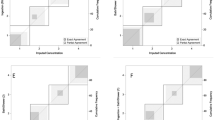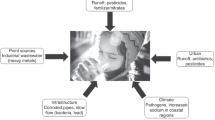Abstract
We are conducting an epidemiological study on the association between disinfection by-product concentrations in drinking water and adverse birth outcomes in the UK, using trihalomethane (THM) concentrations over defined water zones as an exposure index. Here we construct statistical models using sparse routinely collected THMs measurements to obtain quarterly estimates of mean THM concentrations for each water zone. We modelled the THM measurements using a Bayesian hierarchical mixture model, taking into account heterogeneity in THM concentrations between water originating from different source types, quarterly variation in THM concentrations and uncertainty in the true value of undetected and rounded measurements. Quarterly estimates of mean THM concentrations plus estimates of the water source type (ground, lowland surface or upland surface) were obtained for each water zone. THM concentration estimates were typically highest from July to September (third quarter), and varied considerably between water sources. Our exposure estimates were categorized into ‘low’, ‘medium’ and ‘high’ THM classes. Our modelled quarterly exposure estimates were compared to a simple alternative: annual means of the raw data for each water zone. In all, 15–25% of exposure estimates were classified differently. The modelled THM estimates led to slightly stronger and more precise estimates of association with risk of still birth and low birth weight than did the raw annual means. We conclude that our modelling approach enabled us to provide robust quarterly estimates of ecological exposure to THMs in a situation where the raw data were too sparse to base exposure assessment on empirical summaries alone.
This is a preview of subscription content, access via your institution
Access options
Subscribe to this journal
Receive 6 print issues and online access
$259.00 per year
only $43.17 per issue
Buy this article
- Purchase on Springer Link
- Instant access to full article PDF
Prices may be subject to local taxes which are calculated during checkout


Similar content being viewed by others
References
Armstrong B.G. Effect of measurement error on epidemiological studies of environmental and occupational exposures. Occup Environ Med 1998: 55: 651–656.
Bove F.J., Fulcomer M.C., Klotz J.B., Esmart J., Dufficy E.M., and Savrin J.E. Public drinking water contamination and birth outcomes. Am J Epidemiol 1995: 141(9): 850–852.
Box G.E.P., and Cox D.R. An analysis of transformations. J Roy Statist Soc Ser B 1964: 26: 211–252.
Breslow N. Biostatistics and Bayes (with comments). Statistic Sci 1990: 5(3): 269–298.
Cantor K.P. Water chlorination, mutagenicity and cancer epidemiology. Am J Public Health 1994: 84: 1211–1212.
Chen W.J., and Weisel C.P. Halogenated DBP concentrations in a distribution system. J Am Water Works Assoc 1998: 90: 151–163.
Dodds L., King W., Woolcott C., and Pole J. Trihalomethanes in public water supplies and adverse birth outcomes. Epidemiology 1999: 10(3): 233–237.
Gallagher M.D., Nuckols J.R., Stallones L., and Savitz D.A. Exposure to trihalomethanes and adverse reproductive outcomes. Epidemiology 1998: 9(5): 484–489.
Gelman A., Carlin J.B., Stern H.S., and Rubin D.B. Bayesian Data Analysis. Chapman and Hall, London, 1995.
Greenland S. Principles of multilevel modeling. Int J Epidemiol 2000: 29: 158–167.
Krasner S.W. Chemistry and occurrence of disinfection by-products. In: Craun GF, Hauchman FS and Robinson DE (EDs.). Microbial Pathogens and Disinfection By-products in Drinking Water: Health Effects and Management Risks. ISLI press: Washington, DC, 2001: pp. 61–209.
McGuire M.J., and Meadow R.G. AWWARF trihalomethane survey. J Am Water Works Assoc 1988: 80: 61–68.
Nieuwenhuijsen M.J., Toledano M.B., Eaton N.E., Elliott P., and Fawell J. Chlorination disinfection by-products in water and their association with adverse birth outcomes: a review. Occup Environ Med 2000a: 57: 73–85.
Nieuwenhuijsen M.J., Toledano M.B., and Elliott P. Uptake of chlorination disinfection by-products: a review and a discussion of it's implications for epidemiological studies. J Expos Anal Environ Epidemiol 2000b: 10: 586–599.
Spiegelhalter D., Thomas A., Best N., and Gilks W. BUGS 0.5, Bayesian inference Using Gibbs Sampling manual (Version ii), 1996: Available at:http://www.mrc-bsu.cam.ac.uk/bugs.
Titterington D.M.T., Smith A.F.M., and Makov U.E. Statistical Analyses of Finite Mixture Distributions, Wiley, New York, 1985.
Toledano M.B. Chlorination by-products and adverse reproductive outcomes: a retrospective semi-ecologic study in three regions in England, PhD thesis, University of London, 2004.
Whitaker H.J. Exposure assessment of chlorination disinfection by-products for use in epidemiological studies of water quality and birth outcomes, PhD thesis, University of London, 2002.
Whitaker H., Nieuwenhuijsen M., Best N., Fawell J., Gowers A., and Elliott P. Description of trihalomethane levels in three UK water suppliers. J Expos Anal Environ Epidemiol 2003a: 13(1): 17–23.
Whitaker H., Nieuwenhuijsen M.J., and Best N. The relationship between water chloroform levels and uptake of chloroform: a simulation study. Environ Health Perspect 2003b: 111(5): 688–694.
Acknowledgements
The Small Area Health Statistics Unit is funded by a grant from the Department of Health, Department of Environment and Rural Affairs, Health and Safety Executive, Scottish Executive, National Assembly for Wales and Northern Ireland Assembly. The views expressed in this publication are those of the authors and not necessarily of the funding departments. We are grateful to United Utilities, Severn Trent Water and Northumbrian Water for providing the data, and to John Mitchell for creating the figures.
Author information
Authors and Affiliations
Corresponding author
Rights and permissions
About this article
Cite this article
Whitaker, H., Best, N., Nieuwenhuijsen, M. et al. Modelling exposure to disinfection by-products in drinking water for an epidemiological study of adverse birth outcomes. J Expo Sci Environ Epidemiol 15, 138–146 (2005). https://doi.org/10.1038/sj.jea.7500380
Received:
Revised:
Accepted:
Published:
Issue Date:
DOI: https://doi.org/10.1038/sj.jea.7500380
Keywords
This article is cited by
-
Comparison of Trihalomethane exposure assessment metrics in epidemiologic analyses of reproductive and developmental outcomes
Journal of Exposure Science & Environmental Epidemiology (2023)
-
Matrix-Based Fertilizers Reduce Nutrient Leaching While Maintaining Kentucky Bluegrass Growth
Water, Air, and Soil Pollution (2010)
-
Evaluation of two methods of interpolating quarterly trihalomethane levels between sampling dates
Journal of Exposure Science & Environmental Epidemiology (2009)
-
Evaluation of the Webler-Brown model for estimating tetrachloroethylene exposure from vinyl-lined asbestos-cement pipes
Environmental Health (2008)



